




The Tahoe Keys Marina has seen better days and is hoping to see better days to come. We take a look at plans to revitalize the site and create a bustling waterfront.





















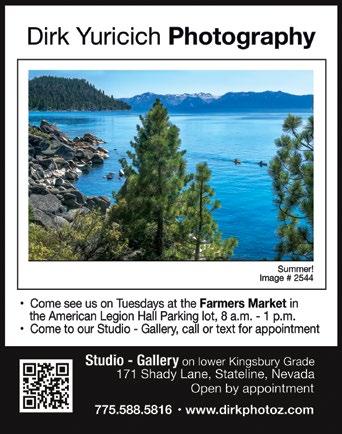

Whether you’re new to hiking, aiming to conquer challenging trails, or looking to improve your overall performance, physical therapy can be a game-changer.
Consider working with a physical therapist to assess your fitness level and develop a plan tailored to your hiking aspirations. The stronger you become, the more incredible every hike will feel!
SCAN HERE TO LEARN MORE!


The Mountain News was just going to press last month when word spread throughout the community about the death of 13-year-old Giada Lancellotti. She was struck by a car while crossing the road at Sawmill Pond. I did not know Giada, specifically, though we knew the Lancellotti family from our days at the Magnet School. They were always friendly and my heart breaks almost as much for the family left behind with a permanent hole in their lives as for Giada. By all accounts, Giada was kind, exuberant and smart and, at a young age, exemplified the maxim carpe diem. Those wishing to donate to the Live Like Giada Memorial Scholarship that has been established in her name can visit https://edcf.fcsuite.com/ erp/donate/create/fund?funit_id=4366.
While the results of the investigation into this particular devastating accident haven’t been publicly released yet, Tahoe Guy says there are things the community can do now to improve traffic, bicyclist and pedestrian safety in South Lake Tahoe. The way our thoroughfares are designed and managed can reduce the number and severity
of accidents throughout our town. He digs in this month with a primer, which while may seem a little wonkish, includes research and examples contributing to a comprehensive understanding of the issue and outlining where we can go from here.
Speaking of wonkish, I have to mention Laurel Ames, a Tahoe environmental pioneer who died in late May, one month shy of her 86th birthday. Motivated by her love of the natural world which sparked her spirit from childhood beginning at a cabin on Emerald Bay Road where she moved in 1947, Laurel fought to preserve and protect Tahoe from environmental damage and destruction.
Given her activism and her history in town, generally, I often turned to Laurel for comment or just background on stories I was writing. While many of my sources over the years have had a general position on an issue supported by a few data points and a pithy quote, I knew if I was going to talk to Laurel, I better be ready to sit for a while. She could cite chapter and verse about whatev-

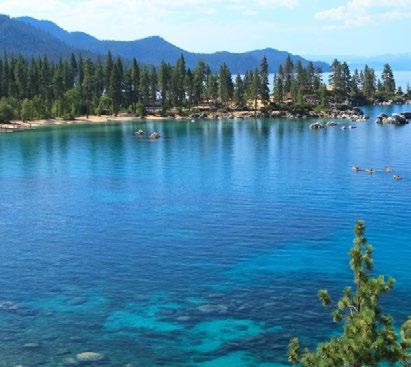

er she was talking about, often in mind-numbing detail, though I always came away more deeply enlightened and I hope our readers did, too.
Laurel wasn’t just someone who valued the outdoors in the abstract. No matter what the season, she regularly took to the backcountry in all manner of endeavors. She was sharp and witty and a delightful human being.
But she also meant business. Almost thirty years ago, when I first moved to Tahoe, I became friends with another woman about my age. (I am not naming her because she told me this story privately). One weekend, this woman, who was working at the Sierra Nevada Alliance with Laurel, got engaged to her longtime boyfriend. She eagerly returned to work on Monday, ready to share the happy news and show off her ring. Laurel’s response was “Congratulations! Now it’s time to get back to work.”
And now I need to get back to work, too, wrapping up this issue and getting this puppy to bed. -Heather
Tahoe has no shortage of people who think big, inspire others, and get shit done.
Local Rob Giustina had the big idea to bring free concerts to the community. Opportunity and inspiration struck with the renovation of Lakeview Commons in 2012. His big idea became Live at Lakeview. His Thursday night summer music series (115 concerts and counting) rocks the town in the best way, all because one guy was thinking big.
On the Fourth of July, Rob casts himself as the unofficial parade MC, broadcasting from his backyard perch at the end of the parade route. Mr. Giustina is the definition of community spirit and originality.
In 2018, locals (Darcie Goodman Collins and Chris and Viktoria McNamara) imagined the Longest Dinner Table event on Ski Run Blvd. They set up tables in the street that could be purchased to raise money for different causes. They asked participants to bring their own food, dress up in wild costumes, and decorate their tables to compete for the coveted Winner's Trophy. Think Halloween meets Summer Solstice street party. Check it out: www. longestdinnertabletahoe.com. Professional event planners can only dream of creating such wildly successful happenings. But locals: they get the job done.
Every non-profit and service club in this
town runs on the power of volunteers. Collectively we are an army of citizen volunteers. We build trails, staff events, feed the needy, pick-up trash, deliver meals to seniors and so much more. This year the Tahoe Chamber named Roberta Strachan, Kelly Tillson and Kelly Escobedo as volunteers of the year. Congratulations, ladies.

Attorney Andrew Pierce, who represents the SLT Property Owners Group (Bob McIntyre, Mark Salmon, Duggan Smith and others), has asked the court to order the city to pay him $1,289,000 in legal fees (billed at $850 per hour) as the prevailing party in their lawsuit against the city and Measure T. On June 23, the city started accepting VHR applications from former VHR permit holders who could start renting their houses as early as July 17.
In the meantime, the Tahoe Neighborhoods Group, of which I am a member, has filed an appeal of the ruling against Measure T. A date for the trial has not been set. The Measure T Defense Fund
has been established to help finance the appeal. Make checks to: Tahoe Neighborhoods Group, LLC and mail to TNG, c/o PO Box14486, SLT, 96151.
Digital Coupons: Buying groceries shouldn’t be frustrating or piss people off. If an item is on sale, just give everyone the sale price. How hard is that?
Rebranding: The latest entries in the rebranding bloopers competition are Harvey’s changing its name to—wait for it—Caesars Republic, and Live Violence Free—sit down for this one—to Vista Rise Collective. Someone should have paid more attention to the Lake Tahoe Visitors Authority’s big flop when they tried to rename the South Shore as Tahoe South. It didn’t exist on a map and was confusing to everyone.
MS. AMES
She was Laurie Wakeman when her family moved to Tahoe in 1947. With only a few hundred people living in Tahoe, books and the great outdoors became her source of adventure. Since the county library operated
out of her family’s home on Emerald Bay Road, she had access to all the books she could read. Closed off from the outside world during the epic winter of ’52, she recalled only that school was cancelled, and the kids had all day to play in the snow, completely unaware that food and supplies were running dangerously low. She skied (downhill and XC) like an Olympian.
As an adult she became a fierce protector of the environment powered by the conviction that she could make a difference. There isn’t anyone who fought harder to protect Lake Tahoe. OK, maybe John Muir. She gathered signatures to incorporate the city, thinking local control would protect the lake from more catastrophic development like the Tahoe Keys. She was either in the room where things happened or on the front lines making things happen. She was unwavering in her belief in conservation and along the way became a local legend in the world of environmental protection. She was authentic with a kind spirit and a childlike sense of fun. In May she slipped away from this world, leaving behind a trail of environmental victories and the people she inspired to think environmentally.
To be continued….
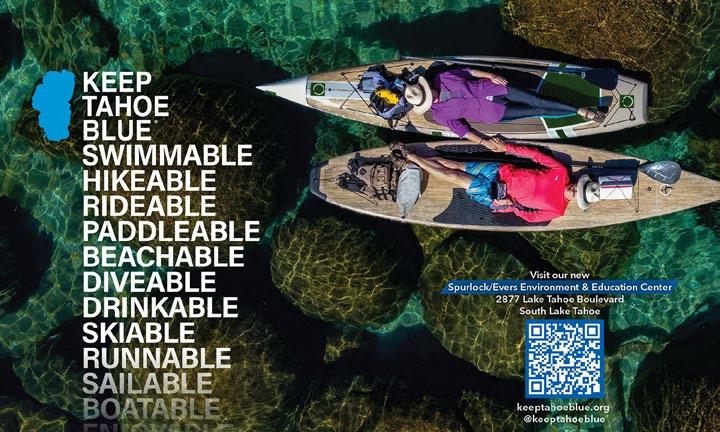
“If TRPA is really concerned with protection of the lake from mussels and invasive species, shouldn't all watercraft be required to pay and be inspected?”
– Josh Richmond
Motorized boats entering Lake Tahoe have been subject to mandatory inspections for aquatic invasive species (AIS) since 2008. It’s optional for non-motorized watercraft like kayaks and stand-up paddleboards.
“Motorized watercraft pose a much greater threat of transporting aquatic invasive species because of their internal complexity compared to human-powered vessels. Mud, plants, animals and especial-
North America in the Sacramento-San Joaquin River Delta in October 2024.
“AIS compete with native species and can increase algae growth that contributes to the decline of Lake Tahoe’s famous water clarity. AIS damage boats and gear by building up on rudders, hulls, and paddles,” the inspection program’s website says.
“The most serious threats to streams and lakes in the Lake Tahoe region are zebra, quagga, and golden mussels, and hydrilla. These AIS are not present in Lake Tahoe. Once AIS are introduced and establish a local population, they are extremely costly to control and often impossible to eradicate.”

While it’s not mandatory for non-motorized craft to be inspected, it is illegal to carry or introduce aquatic invasive species in the Lake Tahoe region, so there are legal protections in place.
Cowen also said any vessel could be subject to inspection and decontamination.
This is the third summer a solar-powered cleaning station has been located at a few of the pop
Part of the larger boat inspection program is the League to Save Lake Tahoe’s Tahoe Keepers group, which is voluntary and free for human-powered vessel operators. More than 7,500 people have gone through the training process.
“Tahoe Keepers have learned how to keep their equipment free of invasive species at home, or with their own materials,” Cowen said. “We also have roving inspectors educating non-motorized watercraft users to use the machine and the importance of being clean, drain, dry. It will take time to normalize the behavior and establish the value of CD3 machines.”
For now, there is no plan to mandate kayaks and the like be inspected. Cowen said the challenge to create such a program is not feasible because these vessels can be launched from just about anywhere, including private beaches and docks.
That’s why the “clean, drain, dry” mantra is being underscored to prevent the spread of AIS into Lake Tahoe and elsewhere by any type of watercraft.
“We have doubled the number of roving inspectors working at popular beaches who are authorized to direct people to an inspection station for an inspection, or to use a CD3 machine,” Cowen said. “Rangers at entry kiosks are also trained to screen people entering with non-motorized craft and can also direct people to an inspection station if there is a risk of introducing invasive species.”
Another resource for all users of Lake Tahoe is TRPA’s boating app. Alerts tell users when new protocols are implemented, as well as rules to prevent the spread of AIS.
Email: mountainnews2@gmail.com Mail: P.O. Box 8974, South Lake Tahoe, CA 95618.
ly water can harbor aquatic invasive species,” explained Jeff Cowen, Tahoe Regional Planning Agency spokesperson. “Human-powered vessels are much more likely to dry quickly, eliminating much of that risk, than motorized vessels that have engines and ballast tanks that can have unseen water in them.”
TRPA and Tahoe Resource Conservation District manage the Lake Tahoe Watercraft Inspection Program. Mandatory decontaminations are required for all visiting motorized watercraft entering Lake Tahoe, Fallen Leaf Lake, and Echo Lake.
Fees are based on the length of the watercraft, with the minimum being $30. It costs $350 to decontaminate a mussel-encrusted vessel.
Lake Tahoe inspectors for the first time discovered golden mussels on a vessel at the Alpine Meadows station this season. This invasive mussel was first detected in
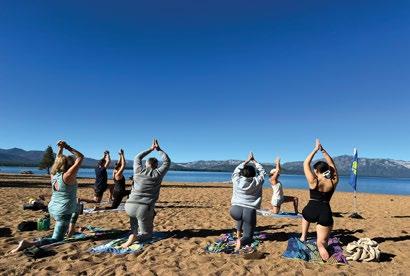



























Publisher’s note: This is one in a series of stories written by immigrants living on the South Shore. Names are being withheld to protect the individual who wrote the story and her family.
Hello, I want to tell you how we came to the USA.
My husband and I came here in 1992 when we were 38 years old. We started working in homes and hotels, doing general cleaning.
In 1993, some people from Sacramento came to promote the idea that the Immigration Department was authorizing political asylum for Mexicans. We agreed to this process because we needed to be in this country legally. By then, our daughter was already with us. We applied as a family, and the appointment with immigration arrived, and everything was real.
They gave us work permits and Social Security cards. We decided to work legally, and that's how I was able to get health insurance for the three of us. Thank God. Our daughter entered high school and the three of us went to learn English at the community college.
God also gave us another blessing; we had a son. So, my husband and I had to work harder at the casino. I also worked for California State Parks, cleaning and doing maintenance. I had never used a shovel or a pick to dig. I taught myself to use several tools, to clean bathrooms and showers, and to paint the walls of the bathrooms. I worked there from 7am to 3pm
When I left the park, I would come home to shower and go to the casino because I worked there from 4pm to 12am. That was in the summer, but on my day off, I cleaned houses.
When they closed the park for the season, it was just the casino and the houses. I thank God very much because all the owners were very good to me. There was one whom I think was very rich as he had a threestory house. It was beautiful, and he would give me the key to his house. On days when they weren't there, I would do my work, and they would leave my check on the desk. They trusted




me a lot; God bless them always. There was also a teacher at the high school who supported and guided my children along the right path. Thank you so much, teacher. God bless you always.
Sometime later, we moved to Reno for better pay. My husband worked doing maintenance for apartments, and I worked cleaning clinics. Everything was going well. Then to our surprise, we received a letter stating that our immigration application had been denied.
We hired a lawyer in San Francisco. He assured us we would win the case, charging us $10,000 for his representation of my family.
We continued working to pay the lawyer, but later we realized the lawyer had done nothing for us, and sadly, we lost our money. Immigration notified us that it had been a national fraud, and we had deportation orders.
You can imagine what we felt as parents—even more terrible when they located us at our jobs. They detained me and they could not locate my husband. They went to our house knocking very loudly on the door and scaring our 12-year-old son who opened the door as he was getting ready to go to school.
I called my husband because the officers told me to tell him to turn himself in. My husband went home and turned himself in. They called my daughter, saying she had to turn herself in to leave the country. My daughter chose to seek legal advice and leave the country of her own free will, which she did

and arrived the next day at the embassy in Guadalajara, Jalisco, Mexico.
I asked our son to stay with some relatives. They received him very gladly, thank God. When we were jailed, it was terrible and humiliating. They treated us like bad criminals. When that happened, we were 52 years old. We only came to this country to work, support ourselves, and give our children an education. Once inside the prison, they separated my husband and me. They then asked us to take off our clothes and searched us to see it we were carrying anything hidden inside. For us, it was the worst humiliation because we have always been good and polite people. They forced us to shower with cold water and gave us uniforms. After that arrest, I developed diabetes and my husband developed high blood pressure, which we still suffer from. Inside the prison, my husband was assigned a cellmate who was going to be sent to another prison because he had been sentenced to 99 years for murder. I was assigned a cellmate who probably had
tuberculosis, which was another fear for me.
After three days, they sent us to Sacramento, and from there to the Tijuana border. From the moment we left Reno, they handcuffed us with a chain that surrounded our waist and feet, treating us as if we were the worst people in the world. When we arrived at the border, they took us out at 1am. They never considered the release time and the crime problem along the border.
When we were here in the U.S. working with immigration permits, we never asked for food at the places that offered assistance, nor for Medi-Cal. We always worked very hard to support our family and cover all the needs such as rent, food, housing, car payments, car insurance, and health insurance.
Although our son was born in the U.S., we never asked for help.
Sometime later, our son
left for Mexico with us. He spent three years in middle school and one year in high school, but he couldn't adapt to the Mexican educational system. He returned to the USA at 15 and continued his studies here in high school. Meanwhile, my daughter, my husband, and I remained working in Mexico. Sixteen years passed since we were deported. When our son turned 21, he hired an attorney to file a petition for residency for us, his parents. Thank God we are now with him here in the USA. I just want to say that there are many very good people in this country, and I always ask God to bless them. There are also some racist people, and I ask God to give them a good heart and good eyes so they realize that we only came seeking the well-being of our children.
Thank you for reading, and may God bless you.













•Hearingbutnotunderstandingcertainwords?
•Difficultyfollowingconversationinnoisysettings?
•Frequentlyaskingpeopletorepeatthemselves?
•NeedtheTVorRadioturneduptoahighvolume?

To the editor,
Re: Not a fan of immigrant stories (May 2025)
Keep the immigrant stories coming! Let us all not forget that unless you are Native American, we are all immigrants here. Whether first generation or fourth, our forefathers all came from somewhere else to build a better future in America. My family left Russia, which was then the USSR, and traveled through what is now Ukraine and then through Poland. They came to America through Ellis Island; the spelling of our last name changed, as my great-grandfather walked through the gates onto American soil. They came here for a better future and worked hard for it.
While "not a fan of immigrant stories" thinks that "they didn't have the integrity to stay and fix their system like our forefathers did, but came to steal some of ours," I think you are wrong. Perhaps
you have never traveled to countries with problems that are much bigger than our own; countries that have regular political coups, gangs that are out of control, or poverty that threatens to destroy your family.
While our immigration policy is much different than the days of Ellis Island when America had its gates wide open, people are still just coming here to make a better life for themselves, not steal from our system. In fact, most immigrants do the exact opposite; they contribute to our system by holding jobs, paying taxes, and doing the work that others will not do. Immigrants do all of this to make a better life for themselves and their families, just like "our forefathers" did. If you think immigrants can fix their system, again I think you are wrong. Just as we cannot fix the broken parts of our system.





Debra Scolnick
To the editor,
The Douglas County Sheriff’s Office’s boat patrol program centers around prevention through education.
Most common are persons on paddleboards and kayaks without a personal floatation device. We typically either provide them one or send them back to shore.
When it comes to violations on vessels, we see transom and bow riding a lot, and boats with no spotter while towing a wakeboarder or skier.
We find violations when we conduct safety inspections. Numerous items are required on vessels such as PFDs for everyone, a type 4 throwable device, working horn, operational fire extinguishers, navigation lights after dark and so on.
Jet Skis usually cause problems by creating a wake too close to shore. They can also get overloaded when towing. There needs to be enough room on the vessel for everyone, including the person getting towed.
Jet Skis also do not typically have navigation lights unless they are aftermarket. That means they can’t be on the water after sunset or before sunrise.
The most common emergency calls are propeller strikes, drownings/medical incidents, vessels in distress, and missing persons.
Primarily, we deal with everything
on the lower half of the lake. South Lake Tahoe PD and El Dorado Sheriff’s Office are our main partners.
Our normal patrol takes us from Stateline to Deadman’s Point just north of Glenbrook. We spend most of our time patrolling Zephyr Cove, Round Hill and Nevada Beach. Nothing with a motor or sail is allowed inside the restricted area at Nevada Beach.
We strive to patrol from Memorial Day to Labor Day. Hours differ so we can focus on enforcement without everyone knowing when to expect us. We always want to be on the water between noon and 4pm when the winds pick up.
Technology and enhanced lifesaving mechanisms have definitely been the biggest changes through the years. We have an ROV that can recover a person from the bottom of the lake, no matter how deep they are. We have a launcher that can shoot a tether to someone approximately 100 yards away. That tether can be used to pull them to our vessel or they can pull a life jacket to them. The launcher is great for the areas inaccessible to our vessel due to rocks.
Ron Elges, undersheriff, Douglas County Sheriff’s Office





June’s 20th annual Tahoe Bike Month was one for the record books. Participation was up 18 percent and riders collectively logged 10,880 bike trips for total mileage of 80,982 miles with 5.6 million vertical feet of elevation gain.
Dr. Jeffrey Cummings and Dr. Scott W. Southard are back in Tahoe full time, joining Barton Health’s Tahoe Orthopedics and Sports Medicine. Cummings focuses on knee and shoulder injuries and Southard specializes in sports-related injuries and restoring joint function.
Wildflower expert Molly J. Ferry will offering free wildflower walks twice weekly around the Tahoe region. Wednesday walks feature a leisurely stroll and Friday hikes are more ambitious. Visit https:// sites.google.com/view/tahoe-plant-book/ home/event-calendar for the dates and locations of specific hikes and more information.
California Senator Adam Schiff will be hosting this year’s Tahoe Summit at Valhalla on August 6. Go to https://tahoesummit.org/register/ to sign up.
The South Tahoe Bears 7th-grade club basketball team will be holding tryouts on August 13 from 4pm to 6pm at the Lake Tahoe Community College gym. Email waltermorris24@gmail.com to confirm participation.
More than 650 volunteers participated in the League to Save Lake Tahoe’s July 5 Beach Cleanup Participants reported 26 percent less litter than last year, totaling 1,375 pounds. Volunteers collected less than 100 pounds of trash at Zephyr Cove, which was inundated with litter two years ago, following the Tahoe Blue Beach initiative, a partnership between the League and the US Forest Service.
Local artist Phyllis Shafer’s painting,
“View From Grant Lake,” has been added to the permanent collection at the prestigious Crocker Art Museum in Sacramento. It was donated by William Douglass of Reno, an expert in Basque studies.
Donate blood July 21 from noon to 4 p.m. at Whole Foods in South Lake Tahoe. Make an appointment here: https://shorturl.at/zePvB.
Stateline resident Len Kyle donated 20 LifeVac devices to the Douglas County Sheriff’s Office to be used by the patrol and jail divisions. The handheld suction device can clear airway obstructions caused by choking.
South Lake Tahoe’s skate park has been revamped with updated features including ledges, rails and ramps.
Need a place to donate old towels?
Lake Tahoe Wildlife Care will take them.
There's a collection box at Zephyr Cove Tennis Club next to the grill to donate gently worn athletic shoes for reuse and resale by the MORE Foundation which funds reforestation, environmental training and tools, creating jobs for youth and providing lessons in environmental health in Africa.
July 19 from noon-6 p.m. is the annual Optimist Club’s Day in Paradise at Tahoe Paradise Park, including the duck races.
Live Violence Free, once known as South Lake Tahoe Women’s Center, is now called Vista Rise Collective
El Dorado County Supervisor Brooke Laine, whose district includes Lake Tahoe and other parts of the county, is running for a second term.
Shedcat Distillery in SLT earned two silver and two bronze medals in the San Francisco World Spirits Competition.
July 20 is the last day to submit com-
ments about the Spooner Lake & Backcountry State Park master plan (https:// shorturl.at/onZmm).
Lake Tahoe Community College Foundation’s Taste of Gold fundraiser is Aug. 9 at LTCC.
A pilot program to relieve congestion around Emerald Bay is running July 15 to Oct. 15. Take public transit from 9am to 5pm A roundtrip costs $10, $5 for kids younger than 13. More info and tickets are online: https://shorturl.at/2oDJW.
South Lake Tahoe Windjammers Yacht Club’s Beer Can Races are every Wednesday night through Sept. 24. Email rearcommodore@sltwyc.com for details.
To address the lack of international visitors to the U.S., at its June meeting, Visit California’s board of directors allocated 91 percent of its media budget to domestic markets for fiscal year 2025-26; it was 72 percent for 2024-25.
California Tahoe Conservancy’s parking lot at Elks Club Drive and Highway 50 is closed now through Sept. 26 as it gets a makeover. The river and forest are still accessible.
More than a dozen bartenders will be participating in the 13th annual Tahoe Bloody Mary Festival on Aug. 10 at Tahoe Beach Retreat.
Donations to the Nevada Youth License Fund is allowing the Nevada Department of Wildlife to offer a free fishing/hunting license to kids ages 12 to 17, available while supplies last. Check out https://nevada.licensing.app/ for details.
Caltrans this month awarded South Lake Tahoe a $255,852 grant to prepare the Stateline Avenue Complete Streets Study
On the third Thursday of July and August from 2pm to 3pm, stop by the




South Lake Tahoe pool for Storytime with a Mermaid; cost is $4.
The Tahoe Regional Planning Agency will be hosting an interactive workshop to address housing in the community on July 22 from 5pm to 8pm at Bijou Community School. Food, Spanish interpretation and kids’ activities included.
Nearly 200 students, the largest class ever, graduated from Lake Tahoe Community College on June 27. South Lake Tahoe City Manager Joe Irvin, an LTCC alum, was the keynote speaker.
Pick up Take It Slow, Tahoe yard signs at Raleys, the South Lake Tahoe Library and the TRPA Office.
The All 80s South Tahoe High School Reunion for anyone who graduated from 1980-1989 will be held on September 5 from 4pm to 7pm at South of North Brewing, followed by the STHS football game.
Share ideas and priorities about restoring the Upper Truckee Marsh, including the Motel 6 site, by emailing info@ tahoe.ca.gov.
The community’s water quality meets or exceeds all state and federal standards, according to the South Tahoe Public Utility District. For the full report, visit www.stpud.us/water-quality-reports.
The Al Tahoe Firewise Clean-Up and Chipping Day is August 2 from 9am to 3pm. Meet and greet and bake sale to be hosted at 768 Los Angeles Av. Also, paper and document shredding available at South Tahoe Middle School. Got a community item for Heard? Email mountainnews2@gmail.com, subject line “Heard.”





You might have noticed that it’s fire season, though it’s getting harder to tell when it’s not fire season. And fire season tends to put you on higher alert when you smell smoke or hear thunder or even just when the wind is up.
And all of that naturally turns your thoughts to fire insurance, which everyone knows has become a precarious, yearto-year thing. You feel lucky if you have coverage and aren’t paying more than 5K a year. Many are now depending on the California FAIR Plan and then picking up supplemental insurance for everything besides fire coverage. And on top of that, the Fair Plan doesn’t provide nearly enough replacement coverage unless you pay for extended coverages within it.
To make matters worse, in order to keep your fire insurance, yearly inspections are now the norm, and the list of “red flag” items seems to change and grow with each passing year. In fact, the meanings of “defensible space” and “fire mitigation” have changed repeatedly over the past several decades, and the entities who define these things have never agreed with each other.
In the past, we were told by TRPA to maintain drought-resistant landscaping vegetation to hold soil in place, which insurance inspectors now cite as a hazard since it’s near the home. We were told not to rake the surrounding forest down to the bare dirt to avoid erosion, and now insurance inspectors cite pine needles as a fire hazard. The distances at which it’s acceptable to have trees (we live in a forest, right?) changes depending on who’s inspecting. What constitutes native brush and acceptable trimming likewise operates on some mysterious and fluid scale.
I don’t need to go on because you all have experienced the maddening contradictions of the type I describe or similar when you interact with local fire districts and the TRPA.
But now, as we’re in the thick of an insurance crisis, the insurance industry has taken the lead in dictating the rules involving our home materials, the grounds around it, the trees and the rest. What they would like is for you to spend thousands of dollars limbing all trees in the woods around you, cutting most of them down, raking the ground bare, removing any kind of plants or bushes within 100 feet of the house, and so on. If you have a deck, you’re expected to spend thousands
of dollars turning wood into “hardened” products. Even Goldilocks couldn’t pull this off.
So, why am I “fired” up all of a sudden? We just had an inspection by a contractor for the California FAIR Plan, which highlighted the impossible conditions under which we try to secure, and then keep, fire insurance around here.
We’re all supposed to pretend that fire doesn’t fly on the wind and that it’s going to matter if we do all the things they want us to; ideally, we’re supposed to turn our homes into concrete blocks with gravel and sand all around. You might say I’m exaggerating, but if so, not by much.
I get it: insurance companies have been hard hit by all the hurricanes, flooding, fires and all the rest. But something about all of this feels just like the gas, grocery and health care gouging that’s been allowed to go on. They create this climate of desperation and implement insane rate hikes because they’re allowed to and because we’re going to be relieved just to pay it.
At any rate, what I’ve discovered through this process and in talking with folks is that there’s a lot of confusion out there and a lot of people hungering for information that is hard to find, so I have a quick request: anyone who doesn’t mind taking a second to email (below), please share any of this information:
Have you had your home fire insurance dropped?
If not, which company are you with?
If dropped, did you obtain a new policy and through whom?
Any brokers or agents who found a way to make it work affordably for you?
Feel free to include how much it’s costing you annually.
What I’d like to do is compile the information (without names, of course) and share it back out with everyone as it may be helpful.
Thanks, Doc!
Finally, a quick shoutout to Dr. Morris of the Nevada Eye Consultants for the lovely Anne Filce’s two new corneas. Amazing work.
As always, email mikesmutterings@ gmail.com

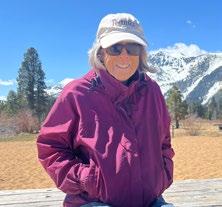
Laurel (Wakeman) Ames, 77-year Tahoe resident and fierce environmental advocate for the Lake Tahoe Basin, quietly passed away this May surrounded by family. Born in Hollywood, California, she moved to Lake Tahoe with her family in 1947. Laurel grew up in what became the Alpina Coffee House on Highway 89. The home was located right on the highway because in winter only highways were plowed. Growing up in Tahoe back then meant attending school in a roving, one-room schoolhouse, riding horses through forests now filled with busy neighborhoods and working in the Wakeman Lumber yard just out the back door.
Always an avid reader, Laurel was fortunate that her mother was the county librarian running the county library out of her family’s living room. Summers at Tahoe always included going to the beach, which meant visiting her best friend Annabelle, who lived in the caretaker’s apartment at Valhalla, now the upstairs of the Boathouse Theater. Winters were spent alpine ski racing, often at one of the many tiny ski hills in the Sierra that are now long gone. One of those hills, The Nebelhorn at the top of Echo Summit, sponsored Laurel’s team the Nebel Hornets—before they moved to The Edelweiss, where Camp Sacramento is today, and became the Red Hornets!
Laurel left Tahoe to attend the University of Colorado at Boulder before obtaining a degree in English Literature from UC Berkeley. In later years, she pursued courses from political science to Italian and earned a master’s in public administration. True to her heart, after college she returned to Tahoe where she would live, love, raise her family and ski and hike everywhere she could.
Growing up in Tahoe surrounded by snow-covered mountains and the incomparable beauty of the Lake, Laurel experienced a life here before the four-lane highway and endless crowds. She understood it was extraordinary and fragile and she knew it was worth saving. She became well known throughout the basin for her unceasing commitment to preserving Lake Tahoe.
She suffered an early loss trying to stop the destruction of the Truckee Marsh to create the Tahoe Keys, then spent years preventing a freeway from plowing straight through the neighborhoods and meadows of our town and across Emerald Bay. She worked for the CTRPA, served on the Lahontan Regional Quality Control Board, helped create the California Watershed Network and was the executive director of the League to Save Lake Tahoe. She was also a founding Director of the Sierra Nevada Alliance, advocated extensively through the Sierra Club and more. Along the way she supported and was supported by countless others.
She continued to fight to protect Tahoe and the Sierra Nevada throughout her life. She never became complacent about the persistent pressures for development in the Tahoe Basin nor believed that Tahoe was safe from them. In fact, her one regret in life was feeling that she had lost the battle to preserve the beauty and clarity of Lake Tahoe from the excesses of development. Still, she never gave up hope that she could make a difference and took the fight to the end.
Laurel’s spirit and commitment to protecting the lake were deeply shaped by growing up in Lake Tahoe, going to school here, working, skiing, hiking, backpacking, sailing and swimming in the lake in a time before Tahoe was “discovered.” She considered herself incredibly fortunate to have lived in such a magnificent place for most of her life. She learned the flowers, she knew the trees. There wasn’t a trail, stream or mountain top that she did not treasure. And in these special places she found her peace and found herself.
Laurel lost her younger sister Jamie Casey a few years back. She is survived by her brother David Wakeman, a former Hornet himself, wonderful nieces and nephews and her daughters Leslie and Jessica, who are grateful for and cherish every minute spent with their mom sharing many of her adventures.
In Lieu of flowers, please donate to an environmental cause that benefits Tahoe or the Sierra. A celebration of life will be held on November 1st at Valhalla. Please bring your memories and stories of Laurel to share.
Sometimes the built environment is so atrocious that a remodel is out of the question and the only way to improve things is with a bulldozer.
That’s what the owners of Tahoe Keys Marina believe.
Suntex Marinas, which has owned
regional manager with Suntex told the Mountain News
“We want it to be a destination,” she said of the marina and the new businesses that are envisioned for the site. “The project will offer multiple dining options: casual dining, upscale restaurant, café, etc.
transform the marina.
Today, people launch their boats and hop on charter vessels at the Keys, but otherwise there is little reason to go there.
With multiple restaurants and shops proposed, as well as an outdoor gathering area, the goal is to bring people to the mari-
Keys Boulevard that was included in the Krilichs’ purchase but is not owned by Suntex.
What Suntex paid for the marina could not be ascertained.
Suntex owns and operates 74 marinas, and manages an additional 18.
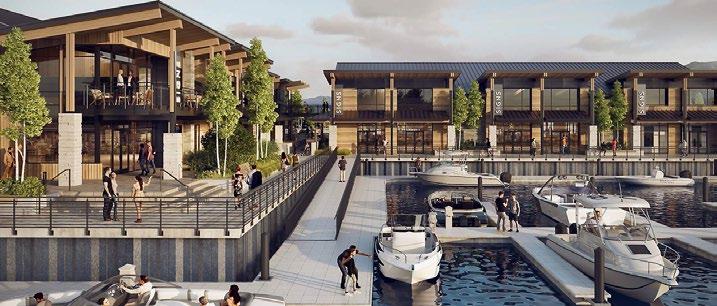
this prime real estate in South Lake Tahoe since December 2021, hopes the wrecking ball will be put to use in 2027.
“Everything is coming down and we will be building brand new,” Katie Linton,
Additionally, it will feature retail spaces, community gathering areas, and waterfront amenities with direct boat access.”
Linton would not disclose how many millions of dollars it will cost to
na who may never get onto the water.
A bit of history
Tahoe Keys Marina was once a bustling lakefront destination, with the Fresh Ketch restaurant one of the most popular eateries on the South Shore for locals and tourists.
Donna and Robert Krilich bought the Tahoe Keys Marina in early 2009 for more than $20 million. Longtime Fresh Ketch owner Bob Hassett in 2013 sold the restaurant to the Krilichs. The El Dorado County Assessor’s Office at the time listed the value of the property and business at $1,224,913. The Krilichs weren’t able to sustain the restaurant and it closed in 2018.

Today, the net assessed value of the 5.67 acres of land on Venice Drive, according to the Assessor’s Office, is $9,100,513. There is also a commercial property at the corner of Venice Drive and Tahoe
The project description submitted by Suntex to the Tahoe Regional Planning Agency says it encompasses “approximately 22.5 acres, of which 14.3 acres are submerged” and that it has existed since the early 1950s. That is a decade before the housing development was built.
Future plans
Even before substantial improvements have begun, Gardnerville residents Lynda and Dave Smith are thrilled with Suntex, saying the company’s professionalism and focus on people leasing slips is off the charts compared to the previous owners.
“They are focused on customers,” Dave Smith said, something they both appreciate.
MARINA
Continued on page 17
Continued from page 16
It’s not unusual for the Smiths to stay on their boat for a day or two or three and never leave the marina.
The couple also looks forward to the structural improvements Suntex has in the works.
Linton foresees the commercial area catering to boating-related businesses, be it apparel, rentals, charters or even a kayak shop. Currently, 25 commercial charters operate out of the Keys.
Linton hopes the Captain’s Corner remains, albeit with a new vibe. It sells souvenirs, snacks and gifts.
The gathering area is slated to replace the current parking lot for the old Ketch restaurant, thus eliminating that parking area.
Suntex is working with multiple agencies to bring its plans to fruition, including the city of South Lake Tahoe (which did not respond to multiple inqui-
community amenities, including an openair plaza, approximately ±1,500 linear feet of publicly accessible waterfront promenade, a central gathering spot of community and recreational events, access and storage facilities for non-motorized recreational uses and public bathrooms with bicycle storage to serve Cove East/Upper Truckee Marsh,” Suntex wrote in its description to TRPA.
The boat ramp location now creates a traffic nightmare, especially on weekends. When the restaurant was operational, it was chaos for diners. It’s also less than ideal in emergency situations.
The improvements call for moving the launch closer to where people pull into the marina off Venice Drive. There will be two lanes for launching, along with a forklift and crane to get the larger vessels out.
The marina plans to institute a launch reservation system to “ensure appropriate
• Replacement of the existing bulkhead and reconfiguration of the existing boat launch and marine fueling facilities.
• Installation of site-wide stormwater infrastructure, drainage facilities, and BMPs.
• Demolition of all existing upland buildings.
• Construction of four new two-story buildings with total floor area of approximately 60,000 square feet containing concession spaces, marina accessory retail, food and beverage establishments and office space.
• Construction of a 65,000-square-foot water and fire flow storage tank(s) and marina facility to, respectively, accommodate large indoor potable water tank(s) to provide the greater Tahoe Keys area additional fire flow and indoor storage of vessels.
• Construction of a two-story, approximately 23,250-square-foot marina support building which will also house office space, three residential units, boat sales, and a dock master with supportive marina services.
• Community and site amenities including a public waterside promenade, multimodal connectivity, and public restrooms.
• Formal approval of 66 existing boat slips in excess of the 239 slips recognized in the adopted TKM Master Plan.
Source: TRPA
ries), the Tahoe Regional Planning Agency, and the Lahontan Regional Water Quality Control Board.
“A central aspect of the project’s goal and objective is to increase public recreation and waterway access through the development of substantial site and
controls are in-place to minimize (aquatic invasive species) exposure, balance the volume of launches with the availability of upland vessel queueing, and promote safe boating practices,” the TRPA document says.
“In addition, vessels that are cur-
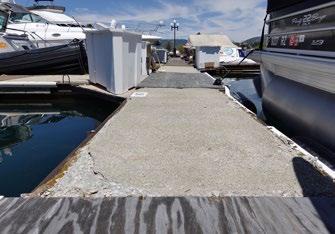
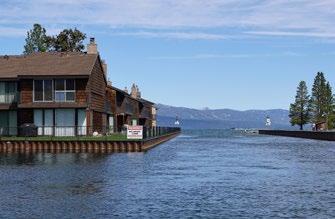
rently stored seasonally and year-round on outdoor boat racks and ground stands will be relocated inside the year-round climate-controlled marina facility to improve the visual and scenic character of the marina while reducing the need for off-site storage and plastic shrink wrapping for winterization.”

TRPA hopes the plan brings the marina into compliance with the Shoreline Plan.
“TRPA documented a number of boat slips above the number permitted
on page 20


SATURDAY
AUGUST 9

6:00–8:00PM
5:00-6:00PM SPONSOR

Spending three winters in Baja Sur, Mexico, turned me into a margarita snob.
I no longer like most margaritas in U.S. restaurants and bars because they are made with a syrupy, pre-mixed concoction. Many have never seen an actual lime other than as a garnish. Fresh limes. That’s what makes an authentic margarita.
I would argue fresh limes are more important than the type of tequila, though I know many would disagree with that assessment.
My sister, Jann, whose place I was staying at in Todos Santos, shared her version of a margarita. It started with making simple syrup, which is equal parts water and sugar. Heat it until the sugar is warm, then cool in the fridge—or freezer to speed up the process. I learned it was best to have this on hand at all times so there would be no delay in imbibing.
Jann used ice, fresh limes, simple syrup, tequila and Cointreau, an orange liqueur. So, so good.
Until my adventures south of the border, I had never used a handheld lime juicer. Oh, my, it’s a great way to easily get all of the juice out of those orbs.
While in Mexico I also learned limes with some yellow peel are juicer.
Then came the day when my niece, Veronica, and I were at a bar in Todos Santos where the waiter asked if we would like our margaritas with damiana. We looked at each, neither having any idea if we would because we didn’t know what it was.
Si, por favor we said. I’ve been saying “yes” ever since.
This amber liqueur was discovered by the Guaycura Indians in Mexico, who used it for religious ceremonies. Damiana is sweet but also woody and minty, with subtle hints of cinnamon when consumed straight. This could be why it’s also good in hot cocoa. It makes sense that damiana can substitute for simple syrup in margaritas because sugarcane is part of the final product.
The damiana plant is traditionally considered an aphrodisiac; it also is said to relieve stress, insomnia, and aches and pains. Might as well call it medicine, wink, wink.
With the introduction of damiana into my life, I’ve created my own margarita recipe.




AVE AT THE “Y”

NATURALFOODS MARKET
SCAN FOR OUR CURRENT SPECIALS

Groceries, dairy, bulk food, organic beer and wine, coffee, energy bars, cereal, snacks, body care products
PRODUCE DEPARTMENT
One of the largest selections of organic produce at Tahoe
NUTRITIONCENTER
Complete selection of vitamins, supplements & herbs

Reliable local contact for your short term rental Available 24/7, 365 days Avoid fines
Professional full service caretaking for your home Project Management ▪ Contractors ▪ House Cleaners





ture public meetings about the project are planned, but no dates have been set. Work this season
Changes will start this summer with all new boat docks. The project could start this month, and will take a few months to complete.
“We will remove the old Styrofoam that goes into the waterway,” Linton said. She said steel frame trusses will be used, with incapsulated foam, and a concrete composite deck.
Dredging in the marina’s channel is slated to start in September and be done the following month.
The marina will be closed when dredging takes place, but boats will be able to use the channels for much of the time.


Linton would not venture a guess as to how many seasons it will take to build out the project, but said at least two. While Suntex hosted a meeting this spring, the 60 or so people in attendance were mostly from the neighborhood. Fu-
“The sediment will stay on site for a period to dry, then it will be removed and taken offsite out of the Tahoe basin,” Linton said. “The east channel at Tahoe Keys Marina has a build-up of over 13,000 cubic yards of sedimentation which is causing navigation challenges. Dredging has not been done in 10 years so there is a lot of material that needs to be removed.”



We want to hear from you! Join us for the second round of hands-on workshops to shape the future of housing in the Tahoe Region.

Tuesday, July 22 from 5–8 p.m. Bijou Community School
South Lake Tahoe, CA
Wednesday, July 23 from 5–8 p.m. Tahoe Community Foundation (formerly Parasol) Incline Village, NV South Shore Workshop

when you re place your old gas powered lawn e quipment with zero em ission cordless e lectric lawn equipment.

Purchase a new cordless electric lawn equipment device from a store or order online.

Apply for the CLIP program at: EDCCleanAir.org
Receive your approved CLIP application via email. Print approved CLIP application.


• Leaf Blower - up to $100*
• Walk-Behind Lawnmower - up to $200*
• Chainsaw, Trimmer, Edger, Brush Cutter, “Weed-eater” - up to $200*
• Ride-On Lawnmower - up to $2,000 * *applicant must fund at least 15% of the total cost of the new equipment. Amounts shown are maximum incentives allowed.
Within 30 days of the purchase of the new lawn equipment, take the old gas powered lawn equipment and the approved application to an approved disposal site. Disposal site will sign application and return to you.
Deliver complete application and copy of receipt for new equipment to EDC AQMD in person or via email. (edcaqmd@edcgov.us )

STEP STEP Applicants must meet specific eligibility requirements:
• Reside and use equipment in El Dorado County.
In 4 to 6 weeks, receive a check from El Dorado County AQMD for your incentive!

• South Tahoe Refuse & Recycling Services - South Lake Tahoe INCENTIVE AMOUNTS:
• Currently own and operate working gasoline or diesel powered lawn equipment.
• Purchase replacement new, cordless, electric lawn equipment.
• Replacement must be like-for-like (chainsaw for chainsaw, etc.)
• Application MUST be approved by AQMD before you dispose of old equipment.
• You must dispose of the old lawn equipment within 30 days of purchase of new lawn equipment.
• Surrender old lawn equipment to:
• El Dorado Disposal MRF - Placerville;
• Radius Recycling (formerly Schnitzer Steel) - Rancho Cordova; <or>


Lake Tahoe Unified School District is wasting no time in spending some of the $127 million to be generated by Measure U, a bond measure approved by voters last November.
Improvements are beginning this summer at South Tahoe Middle School, with the bulk of the money allocated to Tahoe Valley Elementary School.
Both schools will improve their entrances so traffic isn’t backed up onto the street.
The district expects to issue bonds in three rounds, with the first one coming in at $34 million, according to Dave Zebo, LTUSD maintenance and facilities director.
“We will be modernizing the classrooms and existing school,” Zebo said of TVES. This includes a new wing.
This summer the district is working with the Division of State Architect on plans. Work on school buildings in California comes with a layer of oversight that goes beyond the basin’s normal multi-agency rigmarole. Zebo said major construction at TVES will likely begin in 2027, which might be when the next bond installment is issued.
Sierra House Elementary School is also expecting a new building,
which is targeted for the second round of funding.
In selling the measure to voters, the district said, “Funding from a school improvement bond measure would be used to update aging classrooms, labs, libraries, and career training facilities; repair deteriorating roofs, plumbing, heating, cooling and electrical systems; improve fire safety, water quality and school security; replace aging portables with permanent classrooms and remove hazardous materials like asbestos and lead.”
So, not all the improvements will be visible when driving by the various school sites. New fire alarms might be installed this summer at STMS. Inside modernization may be a second phase project.
Zebo said the goal is for “some of these dated schools get the love and attention they need.”
CORE Construction, which has an office in Reno, is the general contractor. Those folks are in talks with district personnel and architects to map out what gets done when.
This month new dugouts at the STMS softball field will be built, along with a pavement project to make access ADA compliant. The soccer field will get


new synthetic turf and the track will be replaced.
The four tennis courts at STMS are slated to be repaved next summer. Zebo wouldn’t venture a guess as to when they were last resurfaced. Repairs were made last summer, with the nets looking new— though they are missing the center strap.
Still, the surface is dangerous, with wide cracks and lines barely visible.
Tennis and pickleball lines are expected to be painted on the resurfaced courts.
“We will probably have to lock and unlock them and govern them, along with the lighting,” Zebo said of what are the only public courts in the city limits. He also stressed new rules for the tennis courts have not been discussed with the powers that be.
If they are locked, that means there would be no public tennis courts in South Lake Tahoe.
The six courts at South Tahoe High
School are off-limits to the general public. This came about in 2010 when they were overhauled with Measure G money. They were locked even though the superintendent at the time said that wouldn’t happen.
“Those will be open to the public, just like at the middle school. Tennis is big in South Lake Tahoe. I could see tournaments coming up here. My dream would be to cover the six at the high school,” then Superintendent Jim Tarwater told this reporter.
A dad was recently playing with his son and daughter at the STMS courts. They ride their bikes to these courts.
While the youngsters sometimes play at Zephyr Cove Tennis Club, it costs to play there, and it requires them to be driven.
The other public court on the South Shore is at Tahoe Paradise Park. The lone court costs $5 to play on, being available on a first-come basis.

Picture this. luscious late spring dusk in Tahoe, the first star of the night teasing the canopy of dimming light. A bicycle rider weaving through the woods, startling deer heading for a nightcap at a hole in the river. Returning home with your mate to soak in a soothing body temperature hot tub. An icy beer winking from the cupholders.
Your eye drifts upward toward your home’s roofline and you see . . what? A long sweep of grayish brown tail feathers protruding from a hole in the cedar siding. A mother bird feeding her chicks? A predator bird caught feasting on an absent mother’s brood?
We watched. Twenty minutes of utter stillness. Whatever bird ventured into that hole had met its undignified fate. Literally stuck with its ass hanging.
Naturally I couldn’t send my back-fused, rotor cuff torn, bicep separated, knee and hip replaced hubby up a skyscraping 20-foot ladder to check it out. It would be
far too dangerous. And that’s why we have children. Ours, 40 years old and titanium free, climbed up and gently wedged the bird carcass from its cylindrical grave. He dropped it to the ground, where our shep-bird-hating dog promptly ate it.
A lot of poor choices and indignities in this life. Just ask P. Diddy.
Yet I’ve been reading about avian versus human intelligence, which was previously assumed not to exist. I mean in birds. We all know it exists in humans, even though it’s not evident when buried under bloated layers of ego. But it got me to wondering why a bird would deliberately seek a strange, dark hole that could threaten its survival. And then I remembered humanity’s inexplicable attraction to casinos and nightclubs. Other dark holes where you can leave your ass hanging.
An interesting fact is, unlike humans, birds are able to plan and learn how to achieve their goals.

This was proven by an interesting experiment involving crows and a pitcher of water so low they couldn’t drink from it. So, they dropped stones into the pitcher, thus raising the water within reach to quench their thirst. Whereas, in a similar experiment, a human faced with a half-empty pitcher of beer will knock it off the table, spilling the rest of the contents on the floor. Then his Labrador will drink it.
Another proof of intelligence is the tool making test. Children were given pipe cleaners to retrieve a sticker from a long tube. All they needed to do was bend the pipe cleaner and fashion it into a retrieving tool. However, they failed miserably, even
though they had been bending and breaking things from birth. When faced with this same task, the crows not only fashioned a hook tool to retrieve the sticker but immediately stuck it on their water bottles and drove home.
Further testing proved that the children needed to view a demonstration to learn how to fashion a tool and retrieve the sticker. When questioned about their new ability, the children declared it worked by “magic.” Today, you’ll find many contractors who embrace this same philosophy.
Another common trait of both humans and birds is “caching.” This means “to hide something away for future use.” This behavior is a means of protecting our goods from potential thieves. Caching birds quickly learn not to hide theirs in front of strangers who are watching them, whereas humans intentionally place their bicycles in full view, depending on a lock to secure them—clearly forgetting that any bike-craving
crow or kid who has viewed a demonstration can fashion a tool to trip the lock.
Another fascinating fact is, unlike American tourists, pigeons can discriminate between paintings by Picasso, Monet and Matisse. This explains why European museums have begun to charge Americans an entry fee, while still offering free admission to the pigeons.
If you’re like me and happen to see a bird with its head in a hole and its ass hanging out, remember all the times the same thing has happened to you. Because we’re all just overgrown, sticker-frenzied children, frustrated when we can’t get what we want. But for “magic” to happen, watch a crow. They seldom drown in a pitcher of beer. And they use their bird brain to fashion a tool rather than plunge into a black hole—because they instinctively know that actions have consequences. So, it’s best to observe, and fly accordingly.


“I think we all bear some responsibility for Giada's death,” I said to Matilda, my daughter and rising 8th grader at STMS.
“What do you mean?”
I take a deep breath. “Everyone who lives here in South Lake Tahoe and has silently put up with the stupid road design we’ve had since the 70s that turned our town into a highway. We should have done something earlier that could have prevented the tragic accident that cut short, at only 13-years-old, the beautiful life of Giada Lancellotti. We are all complicit. We need to do more to make our streets slower and softer and safer.”
Matilda thinks for a minute and then asks, “How?”
I respond with another question. “Do you know that Caltrans bumped the speed limit at Camp Richardson all the way up to 45mph?” I ask Matilda.
“Where the ice cream shop is and all those people are crossing all summer? That seems really fast. I thought we protested against Caltrans doing that exact thing.”
“We did. But that was two years ago when we came together for the ‘Slow Down in Our Town’ Critical Mass bike rally.”
“Should we do it again?”
“Protest?” I ask.
“Yeah.”
“I think we need to do even more than protest this time. It’s time for some serious political action.”
Do we continue letting vehicle speed and convenience dictate the design of our community, or do we reassert the fundamental idea that this is a place where people live, raise children, and walk or ride to everywhere—not a tourist corridor to be rushed through?
The time has come to embrace data-driven, people-first traffic design, throughout our town, including the replacement of signalized intersections with roundabouts, the elimination of dangerous center lanes, and a coordinated effort to make our streets safer for everyone— from tourists to toddlers. This isn’t radical urbanism; it’s practical mountain-town planning rooted in research, experience, and a respect for community values.
The intersection at Sawmill Road and Lake Tahoe Blvd where the tragedy occurred doesn’t even have a stop sign! That is truly insane negligence. Kids and families and cyclists cross there all the time as traffic flies by at highway speeds on a road that is graded and designed to

be just that: a highway. STMS sits at a ridiculously busy and dangerous signalized light. Children are afraid to cross and report issues with the crosswalk light malfunctioning.
I was able to speak with Charles Lancellotti, Giada’s father, and he was gracious enough to provide some of his thoughts on South Lake Tahoe’s infrastructure. Charles said, “As a town, we’re getting better. We have great pieces, but it’s all too disconnected. The Sawmill intersection is a perfect example: there are two wonderful Class 1 segregated bike paths that come together in a horrible intersection.”
Charles is right; we’ve figured out a lot of pieces of the puzzle already, but we have some glaring and gaping holes, specifically those horrible and dangerous intersections exacerbated by our sky-high speed limits and our wide-open-dragracing-conducive-center-suicide-lanes.
According to the National Cooperative Highway Research Program, urban multilane roads with center turn lanes see exponentially higher rates of head-on and side-impact collisions, particularly when speeds exceed 35 mph. In a mountain town where visibility changes with snowbanks, tourist congestion, and seasonal influx of E-everything, the danger multiplies.
As a community, we owe it to our children and to each other to seriously consider less antiquated solutions to our central corridors. The answers are there; they’ve been tried and tested in mountain
towns like Boulder, Colorado, with its inebriated college student population stumbling into intersections and Bend Oregon, with its gorgeous roundabout artwork. We are not reinventing the wheel, we can look at high raised medians, dedicated turn pockets, or pedestrian refuges that would calm traffic, reduce conflict points, and create opportunities for landscaping, signage, or public art that reinforces a sense of place—not speed. Transitioning to safer road design in South Lake Tahoe will require coordination across jurisdictions—but it is entirely feasible. Here are the steps we should be taking:
1. We will need to collaborate with Caltrans (District 3): Caltrans manages Highway 50, but local governments have significant input on corridor planning. The city should proactively request a corridor study focused on Complete Streets design principles, including roundabouts, median improvements, and pedestrian infrastructure. AB 43 (passed in 2021) also gives cities more flexibility to lower speed limits in high-risk zones, especially around schools.
2. We should be actively looking at applying for state and federal Grants: The Safe Streets and Roads for All (SS4A) program under the Bipartisan Infrastructure Law, as well as California’s Active Transportation Program (ATP), provide funding for exactly these kinds of projects -- traffic calming, pedestrian crossings, protected bike lanes, and roundabouts.
3. My ideas are not the only ones. We need to engage the community: A public design workshop process can build consensus and bring forward locallyinformed solutions. Many conservative and business-minded residents may resist change unless they see the economic and safety benefits firsthand—especially when shown local data on collisions, nearmisses, and business impacts.
4. We should prioritize School Zones first: Start with small wins—around Bijou Community School and High School Hill and Sawmill Road and STMS and all along Ski Run Boulevard. These are places where safer crossings, slower turns, and a more village-like feel would immediately protect lives and enhance the visitor experience.
Readers of the Mountain News will likely remember that I have a particular vendetta against the “Snow Snake” and the dump truck parade that we continue to throw millions of dollars at each year whenever it snows more than a few inches. If we reimagine our streets, we can likely also reimagine how we handle snow on them and again make our world safer for all of us who call South Lake Tahoe home. Let’s take this opportunity to really dig into some research on traffic calming infrastructure and street design that enhances community.
Roundabouts: If you’re a holdout on roundabouts, just have an open mind and read the research. Across the U.S., and particularly in towns similar to ours— such as Jackson, Wyoming and Steamboat Springs, Colorado —roundabouts have transformed traffic flow and safety. Bend for example, has installed over 40 roundabouts since the early 2000s. A comprehensive city study found a 78 percent reduction in injury crashes at intersections where roundabouts replaced stoplights or stop signs. The Insurance Institute for Highway Safety indicates that replacement of signals or signs with roundabouts reduces pedestrian and cyclist related crashes by 40 percent.
The logic is simple: roundabouts slow traffic, in our case from 40 or 50 mph to 15 to 25 mph without stopping it, forcing drivers to engage with their surroundings, yielding instead of accelerating, and constantly moving in a calm, deliberate way. This sort of engagement would have undoubtably saved Giada. Unlike traffic TAHOE GUY
Continued on page 30
We do some bike rentals at the shop. Not as much as some people might think, as repair is really what we are about. Having said that, there is a statement we hear at the shop often when customers return their rental bikes:
“Oh, that was a great workout!”
Yeah, okay, great, but nothing about, wow that was really fun or oh my goodness, that was so beautiful! Sometimes it is just a ride to the beach or lunch, you know, nothing epic, but riding. To be sure there are plenty riders who
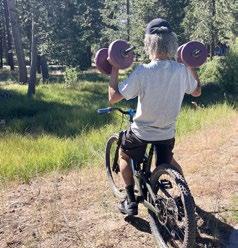
come back absolutely ecstatic and elated and sometimes a little scraped up because it was so much fun, but “a great workout? ” I guess I have a problem with riding just being a great work out. I’m sure it is, but personally, that is not why I ride my bike. It is all about fun, “A and E,” adrenaline and endorphins. Adventure and scenery are paramount to a good ride, too, but a workout?



This whole workout thing goes right along with another little thing I find kind of funny. Whenever you get two or more people riding together, it turns into a, well, not a race but certainly a faster-and-faster, I-amso-fast, hope-you-can-keep-up sort of thing. This never happens with people hiking together. Suddenly the pace picks up, everyone is walking faster, the third person suddenly makes a move to go out front and begins to pull away!
Wow I had no idea she was so fast; I hope she waits at that next
intersection. How about paddlers? Suddenly there is this frenzy of splashing as the pace picks up…I don’t know, I am not a paddler, except for the years I spent whitewater paddling and this never happened on the river, and no one ever called it a great workout—though there were certainly no slouches on the river!
I spent quite a few years as a climber, both rock and ice climbing. Fitness is very important in your ability to get a climb done, yep, never once heard anyone get to the top of some pitch and say,
“Ah what a great workout.” Is it possible I was just ignoring that claim when someone called it out?
Selective hearing loss, blatant disregard for my friends’ feelings about what we were doing out in the woods. Perhaps something in my past made me feel like that


statement is to be used strictly as you walk out the doors of a gym, I don’t know.
I can’t believe it. I stopped writing and went to work this morning. Can you guess what the first rental return said to me? I actually had to work pretty hard to not laugh, not at them, but at how timely their comment was for me (selfish, I know). I had to put on a straight face to ask if they had fun, too. Fortunately for all parties involved, they said they did have fun because I would not have been able to let them get away with just a great work out. Alright, maybe I have gone a little too far with this idea because the thought just occurred to me that the reason I don’t ride an ebike is because I like to pedal; it feels good, it is challenging and if I can climb that big hill, I will be happier having made it to the top under my own power. To be sure, I will be stronger, I will be more aerobically fit, even if I had to walk my bike up some of that hill, and standing at the top, there will be some celebration happening. Because of that, the next day I will be stronger, more fit and ready to try the next bigger hill climb. But I am still not going to call it “a good work out!”! It was just fun.
Let’s play

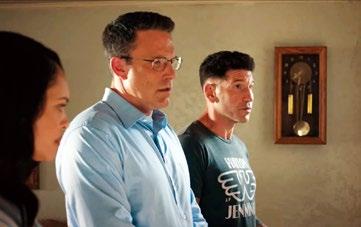
As I mentioned in a couple earlier columns, the movie industry in Hollywood has been hard hit since the pandemic. With a variety of setbacks, Hollywood has been losing money and labor as studios started looking to other areas to do business.
Part of the incentive to leave has been the favorable tax credits being offered by other states, such as Georgia or New York. However, even in a lean budget year such as we are facing now, our legislators have understood the importance of the California movie industry and have approved a tax credit for film and TV production here in the Golden State with a cap of $750 million. This will be competitive with other states and a shot in the arm for a California industry that has been reeling for some time. Though it may be too little, too late, it will still add a few thousand production jobs as it kicks in; however, to compete with other coun-

tries such as Canada and the U.K., there will need to be some federal tax incentives, and with the current administration, that may not be in the cards. But it is a step in the right direction to keep Hollywood in Hollywood.
For films this month, I thought I’d grab a couple of action films that have recently been streaming. Way back in 2016 there was an action thriller called The Accountant. It starred Ben Affleck as Christian, an autistic math savant who hires out as a freelance accountant to criminal organizations. Besides being a whiz at accounting, he has also been trained in weapons and martial arts at the highest level. He is “Rain Man” as an action anti-hero. The film got mixed reviews with most people liking Affleck’s character and some of the action sequences, but not much else.
Well, almost 10 years later they thought, why not make a
sequel? They got the same principal cast together and created The Accountant 2 (out now on Prime). The action kicks in when Christian’s friend and former Treasury Director, Ray King (J.K. Simmons) is murdered. Before he died, he scratched into his arm the message, "find the accountant," and Christian is compelled to solve the case. Since he is dealing with professional killers, he recruits his estranged brother Braxton (Jon Bernthal), a professional assassin, to help. Once again partnering with U.S. Treasury Deputy Director Marybeth Medina, they uncover a deadly conspiracy and become targets for a bunch of killers who are hired to keep the secrets buried.
If you didn’t see or don’t remember the first film, you are not alone, and though it is not necessary to have seen the first film, there are a few pieces that you just have to roll with.
This second film is lighter in tone and focuses more on the dynamic of Christian’s relationship with his brother. Though this is an action-thriller, it also leans toward the buddy comedy as Christian and his polar opposite brother try to evolve their relationship while evading and killing bad guys.
Christian’s former school, the Harbor Neuroscience Academy, now functions as his intelligence service with kids of all ages manning computer screens to take
care of everything from getting detailed information and solving puzzles to hacking any system to get what they need.
The plot is implausible and a bit convoluted, and other than one nice twist, has a lot of formula to it. But the real meat of the film is watching Chris’ and Brax’s relationship go back and forth with humor, heart and action. The action is intense, but not over the top for this kind of film. Teresa remembered liking Affleck in the first film and was only mildly disturbed by the violence while still enjoying the character in this one. With its lighter tone, it’s still not a great movie, but it’s watchable.
The second film, Deep Cover (also out on Prime), is a bit better and more fun. Deep Cover is the story of Kat, an American actress in London who can’t get that big break needed for the road to success. She has taken a gig teaching improv at a local club, while her more successful non-theatre friends begin to worry about her future. When an undercover cop offers her a chance to do some improv in an easy undercover sting, she enlists a couple of her new students: Marlon, another frustrated out of work actor who approaches everything with intense method acting, and Hugh, a lonely tech worker who tends to be very awkward interacting with other people. Together, they are supposed to help expose a store that sells il-

As we continue doing the work to make our system more resilient to extreme fire conditions, we also use three key strategies to safeguard our communities against the threat of wildfires. While these measures help to keep us all safe, they can lead to power outages. We want everyone to be aware and prepared.

legal cigarettes. However, after a series of mistakes, they get pulled into London’s gangland underworld where their improv skills are the only thing keeping them alive. Meanwhile the police, who don’t know they are undercover, begin to track them, thinking they are a new gang taking over London’s drug trade.
The cast is great, with Bryce Dallas Howard as Kat, Orlando Bloom as Marlon and Nick Mohammed as Hugh. The combination of Hugh’s polite nerd with his awkward responses to any situation and Marlon’s intense, over the top energy (as he creates a scenario for every encounter, which has him living a gritty, tragic existence), provides great comic moments with Kat having to think on her feet as she tries to hold it all together. The situation gets more preposterous and amusing with each series of events but never loses energy or focus. The action is handled just the way you would expect with three people who have no idea what they are doing, and since we are dealing with the underworld, there is violence but it’s not overdone.
Overall, Deep Cover is a light, thoroughly enjoyable comedy with a good pace, fun characters and actors who keep the comedy grounded. Other than the occasional gunplay, Teresa really liked it as well.

1| 2| 3|
FIRE SEASON SETTINGS
Sensitive settings on power lines to reduce wildfire risk.
PUBLIC SAFETY OUTAGE MANAGEMENT

Proactive de-energization ahead of extreme wildfire risk conditions.
EMERGENCY DEENERGIZATION

Turning off the power when a wildfire gets too close to power lines to protect first responders and prevent secondary fires.
Visit nvenergy.com/PowerSafeNV to learn more about these strategies and how to be prepared for extended outages during this time of heightened fire risk.
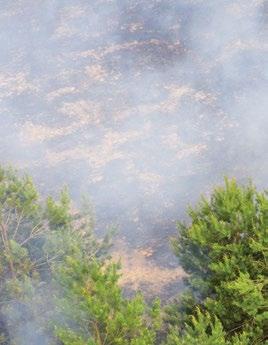




lights, they function during power outages (a regular occurrence in mountain weather) and cost significantly less to maintain over time—no sensors, no bulbs, no electricity.
Concerns about roundabouts in snowy climates are understandable— but misplaced. The Federal Highway Administration has studied snow operations in roundabouts extensively. In fact, both Colorado and Michigan DOTs report that roundabouts perform better than signalized intersections in winter, as plows can continuously sweep the circular roadway without the complex turns and equipment hazards of a signalized intersection.
Roundabouts reduce “conflict points,” these are the pedestrian and cyclist impact zones around an intersection. Traditional four-way intersections have 32 conflict points; roundabouts have eight with dramatically shorter crossing distances. There is also the proven idea of “driver awareness” and engagement that happens with roundabouts as a driver consciously reduces speed and evaluates his or her surroundings.
Now for the Suicide Lane: South Lake Tahoe’s center turn lane—running much of the length of Highway 50 through town—in the 1970s might have seemed


like a practical compromise between traffic volume and local access. Today, it’s a relic of poor design thinking. It is frequently misused as a passing lane or merge zone, inviting conflict between vehicles turning in both directions, pedestrians attempting to cross multiple lanes of traffic, and cyclists just trying to survive.
Unlike raised medians or roundabouts, center turn lanes do not naturally slow traffic, they encourage speed. Wide-open roads with a center lane are statistically proven death zones with no refuge for leftturn vehicles who wait in live traffic or pedestrians and cyclists who are forced to cross almost 80 feet of asphalt desert.
The Transportation Research Record and the Federal Highway Administration found a 56 percent reduction in pedestrianinvolved crashes on roads with raised medians in lieu of center turn lanes. The Florida Department of Transportation states that roads with center turn lanes have a 30 percent to 50 percent higher vehicular crash rate. Nevada DOT research indicates that center lanes experience a 40 percent higher rate of severe head-on crashes. The National Cooperative Highway Research Program found that on five-lane roads with two-way turn lanes, fatal pedestrian crash risk is two times higher compared to raised medians or roundabouts. The research goes on and it’s damning.
Some might argue that slower traffic means reduced efficiency or economic harm. But again, the evidence tells a different story. A 2019 report by Smart Growth America showed that in towns where roads were redesigned to slow traffic—through roundabouts, narrowed lanes, and pedestrian-first signals—local retail sales increased by an average of 20 percent within the first year. Why? Because slower drivers notice storefronts. They stop. They spend. Towns like Golden, Colorado and Carmel, Indiana have reaped the economic benefits of roundabouts while becoming models for safety and livability. In both cases, replacing signals with roundabouts increased safety while reducing vehicle delays—a win-win that’s well within reach for South Lake Tahoe.
On a summer afternoon or a powder day in February, the main artery through South Lake Tahoe—U.S. Highway 50— can feel less like a community road and more like an interstate. Drivers, many unfamiliar with the town, speed through without pause, weaving into the center turn lane or making abrupt lefts across traffic. We’ve all seen the results, it’s gnarlier than your kid’s first time down the Wall at Kirkwood.
South Lake Tahoe is a vibrant alpine town holding onto a proud middle- and working-class identity and fighting













back against the stratification that has turned other mountain towns into empty playgrounds for the uberrich who zip in and out of town not interested in local business, local kids, local values. We are at a crossroads. Who are we? What do we care about? Do we care about vehicle speed or kid safety?
Every time a parent avoids letting their child walk or bike to school because of Highway 50, that’s a failure of design. That’s our failure as a town. Every nearmiss at a crosswalk is a wake-up call to get our collective heads out of the snowbank.
This isn’t about turning South Lake Tahoe into something it isn’t, it’s about recognizing and valuing who we already are. It’s about becoming a more livable, navigable, and safe small town that reflects us—not just who passes through. We live here. Let’s make it feel like it. We owe it to ourselves. We owe it to Giada.
M.C. Behm is a full-time resident of South Lake Tahoe and author of “Once Upon a Quarantine” and “The Elixir of Yosemite.” Available locally and online. To learn more or respond to columns visit www.behmbooks.com or email mcbehmbooks@gmail.com.


































